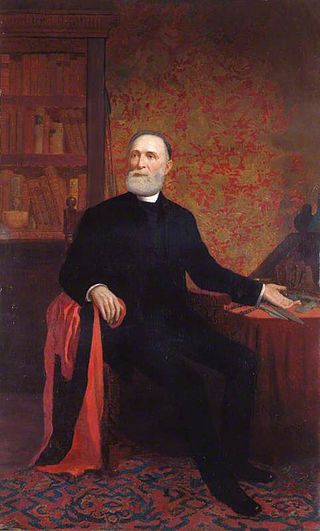Related Research Articles

Sir William Jardine, 7th Baronet of Applegarth FRS FRSE FLS FSA was a Scottish naturalist. He is known for his editing of a long series of natural history books, The Naturalist's Library.

The Royal Irish Academy, based in Dublin, is an academic body that promotes study in the sciences, humanities and social sciences. It is Ireland's premier learned society and one its leading cultural institutions. The Academy was established in 1785 and granted a royal charter in 1786. As of 2019, the RIA has around 600 members, regular members being Irish residents elected in recognition of their academic achievements, and Honorary Members similarly qualified but based abroad; a small number of members are elected in recognition of non-academic contributions to society.

The National Library of Ireland is the Republic of Ireland's national library located in Dublin, in a building designed by Thomas Newenham Deane. The mission of the National Library of Ireland is "To collect, preserve, promote and make accessible the documentary and intellectual record of the life of Ireland and to contribute to the provision of access to the larger universe of recorded knowledge."

William Thompson was an Irish naturalist celebrated for his founding studies of the natural history of Ireland, especially in ornithology and marine biology. Thompson published numerous notes on the distribution, breeding, eggs, habitat, song, plumage, behaviour, nesting and food of birds. These formed the basis of his four-volume The Natural History of Ireland, and were much used by contemporary and later authors such as Francis Orpen Morris.

Robert Lloyd Praeger was an Irish naturalist, writer and librarian.

The Belfast Naturalists' Field Club is a club of naturalists based in Belfast, Northern Ireland. Founded in 1863, the club was an important part of the education system for Victorian naturalists and worked largely through first-hand field studies. It has been credited with playing an important role in the elucidation of glacial and post-glacial sea levels, climates and fossil beaches and issuing the first of the regional handbooks for meetings of the British Association for the Advancement of Science as far back as 1874. The club has four sections, Archeology & History, Botany, Geology and Zoology, and has published several books and a periodical. The Herbarium of the BNFC is now in the Ulster Museum.

William Archer was an Irish naturalist and microscopist especially interested in Protozoa and Desmids.

Richard Manliffe Barrington was an Irish naturalist.
The Clare island Survey was a multidisciplinary survey of Clare Island an island off the West coast of Ireland.

Mitchelstown Cave is a limestone cave near Burncourt, County Tipperary, Ireland. Situated 12 kilometres (7.5 mi) from Mitchelstown, County Cork, it became the first cave in Ireland to be developed for the public in 1972.

John Grainger was an Irish cleric and antiquarian.

Denis Robert Pack-Beresford (1864–1942) was an Irish entomologist and arachnologist.

Jane Stephens was an Irish zoologist who was considered a leading authority on sponges in Ireland with specialised knowledge in other marine life who identified and named over 40 sponges new to science. From 1905 to 1920 she was employed in the Natural History Division of the National Museum of Ireland working primarily on the collections of marine invertebrates, including taking part in the Clare Island Survey. Robert Lloyd Praeger testified to her knowledge of and work with Irish sponges stating that "Most of what we know of this group, whether marine or fresh-water, in Ireland, or off the Irish coasts, is due to her work."

Matilda Cullen Knowles is considered the founder of modern studies of Irish lichens following her work in the early twentieth century on the multi-disciplinary Clare Island Survey. From 1923 she shared curatorship of the National Museum of Ireland herbarium – a collection of dried and pressed plants now housed at the National Botanic Gardens. Her work is said to have "formed an important baseline contribution to the cryptogamic botany of Ireland and western oceanic Europe".
Annie Letitia Massy was a self-taught marine biologist, ornithologist, and an internationally recognised expert on molluscs, in particular cephalopods. She was one of the founders of the Irish Society for the Protection of Birds in 1904. Many of the details of her life are unknown which is attributed to the fact that she is often described as a shy and retiring person, with no known photograph of her in existence.
Veronica Conroy Burns was an Irish museum curator, best known as an expert on graptolites.
Alexander Carte MD, FRCSI, MRIA was an Irish zoologist and palaeontologist and was first director Natural History Museum, Dublin.
Mary Leebody (1847–1911) was an Irish botanist, known for her work on the flora of County Londonderry and County Donegal.
James Edwin Duerden or J.E. Duerden M.Sc., Ph.D., A.R.C.S. was a British zoologist who became an international expert on the wool industry.
Robert Bell was a Northern Irish riveter with Harland and Wolff and amateur geologist, mineral and fossil collector. He was described by Robert Lloyd Praeger as "the working-man naturalist."
References
- ↑ Praeger, Robert Lloyd (1969). The Way that I Went: An Irishman in Ireland. Dublin: Allen Figgis. pp. 10–12.
- ↑ Jackson, Patrick Wyse; Jackson, Peter Wyse (1992). "The Irish Naturalist: 33 years of natural history in Ireland 1892–1924". Irish Naturalists' Journal. 24 (3): 95–101.
- 1 2 Irish Naturalists